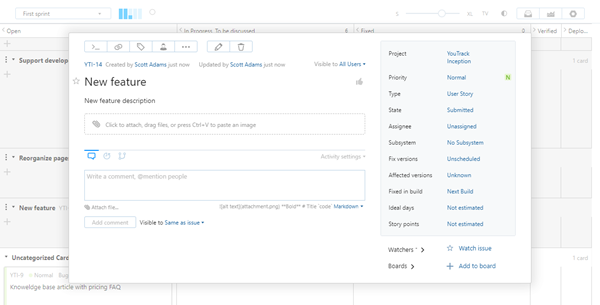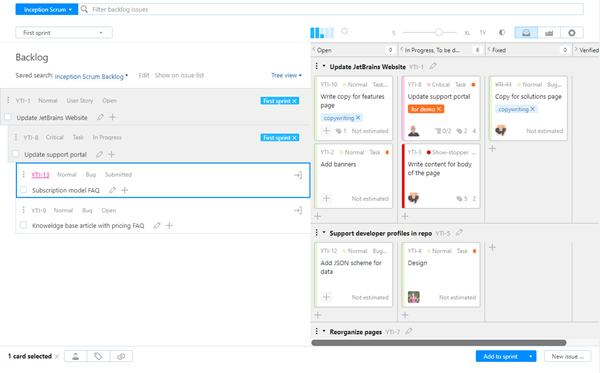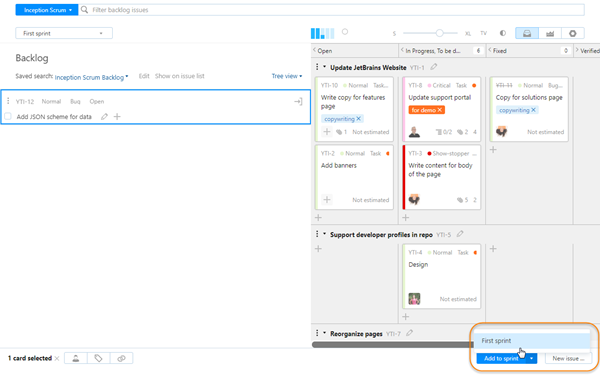Plan a Sprint
Before you start a sprint, your team normally meets to agree upon the set of tasks that will be the focus of your efforts during this timeframe. Follow the instructions on this page to fill the new sprint swimlanes and card during or after the planning stage.
Prerequisites
Please note that at this point, we assume that you have already:
Pull Swimlanes and Cards from the Backlog
The most practical way to add swimlanes and cards to the sprint is to pull the issues directly from the backlog.
To add issues from the backlog:
Select the sprint that you want to plan in the sprints drop-down.
Drag cards from the backlog to the board, or select one or more issues in the backlog and add them to the current sprint:
Issues that are used to identify swimlanes are added as swimlanes on the board.
If a swimlane issue has subtasks, you have the option add its subtasks as cards to the swimlane.
Add Issues with Commands
Sometimes you might want to add issues to the sprint that are not in the backlog. In this case, you can add the issues with a command.
To add an issue to the sprint with a command:
Open the Issues list.
Use a search query to find issues that are not assigned to the sprint. The key search attribute in this case is:
has: -{Board <board name>}For example, you want to locate any unresolved critical issues in the projects that are managed on the board. Here's the search criteria you would use to find issues in the CSS and CMS projects that are not assigned to the CMS Scrum board:#Unresolved #Critical project: CSS, CMS -{Board CMS Scrum}Select all of the issues that you want to assign to the sprint.
Open the Apply Command dialog (just type) and enter the command. Use the format:
board <board name> <sprint name>Here's the command you would use to assign the selected issues to the Sprint-2 Leads Management sprint on the board from the previous example:
board CMS Scrum Sprint-2 Leads ManagementIssues that are used to identify swimlanes are added as swimlanes on the board.
If an issue is linked as a subtask of a swimlane issue, it is added as a card to the parent swimlane. Otherwise, the issue appears in the swimlane for uncategorized cards.
Add New Issues as Swimlanes
If required, you can not only move a swimlane to the board from the backlog, but also create an issue as a swimlane right on the board in a sprint.
To create a new swimlane on the board:
Open the board to the desired sprint.
Perform any of the following actions:
Click the Create button in the header, then select Swimlane from the list.
Click the New swimlane button in the footer.
Press the keyboard shortcut to create a new swimlane.
Windows:
Ctrl + Alt + Shift + Insert
macOS:
Control + Option + Shift + N
The new issue dialog opens.
The value for the field that identifies swimlanes is set automatically. If you use multiple values to identify swimlanes, the first value in the list is assigned to the issue.
The project field is also set automatically. If you manage multiple projects on the board, the first project in the list is assigned to the issue.

In the new issue dialog, enter the summary and description for the issue. You can also set the values for custom fields. The issue summary is shown as the name of the swimlane.
Click the Add swimlane button to add the issue as a swimlane to the current sprint. If you want to add more information to the issue after its creation, click the Add and open button. In this case, the issue is added as a swimlane to the current sprint and opens in view mode.

Add New Issues as Cards
You can create issues directly on the board. Many teams use this option to create the tasks that are required to finish a user story. You can add cards to any swimlane. If you use the swimlane for uncategorized cards, you can add issues to the sprint as orphans.
To add a card to the board:
In the swimlane to which you want to add a task, click the
 icon in any column.
icon in any column.The new issue dialog opens.
In the new issue dialog, enter the summary and description for the issue. You can also set the values for custom fields. The issue summary is shown as the name of the swimlane.
Enter the Summary and Description of the new card. If required, customize other fields.
Click the Add card button to add the new card to the swimlane in the selected column. If you want to add more information to the issue after its creation, click the Add and open button. In this case, the issue is added as a card in the selected swimlane and opens in view mode.
The value that is used to define the selected column is applied to the corresponding field in the new issue.
If you add a card to a swimlane that is identified by an issue, the new issue is linked as a subtask of the swimlane issue.
Estimate Cards
In YouTrack, we provide estimation for tasks only, not swimlanes. Estimation for a swimlane (a user story) is the sum of all estimates of its tasks. The summary estimation value for a swimlane is not displayed, and is not calculated in any report.
Before estimating tasks on the board, you should specify an issue field to be used as Estimation, in the Board Settings. When the Estimation Field is configured in the board settings, the corresponding value is shown in the upper-right corner of each card.
By default, the "empty" value of the selected field is shown on the task card (for example, "No Estimation" or other empty value that is configured for the field used for Estimation).
To add an estimation to a task, click the Estimation Field and enter a value.
Prioritize the Sprint
Prioritizing a sprint is easy. Just drag your swimlanes and cards to place them in the desired order. You can also use a search query that contains a sort attribute to filter the cards on the board. For example, the search query sort by: Priority automatically sorts the cards in each swimlane based on the value that is stored in the Priority field.
The order of swimlanes and cards on a board does not affect the custom order that is shown in the Issues list or change the value of the Priority field. Prioritizing issues on the board is simply a visual indication that swimlanes and issues that appear higher on the board should be finished first.

